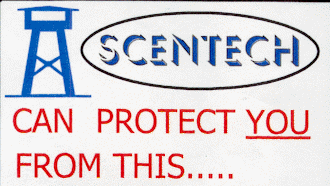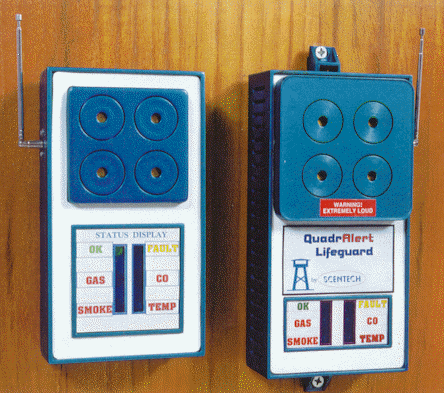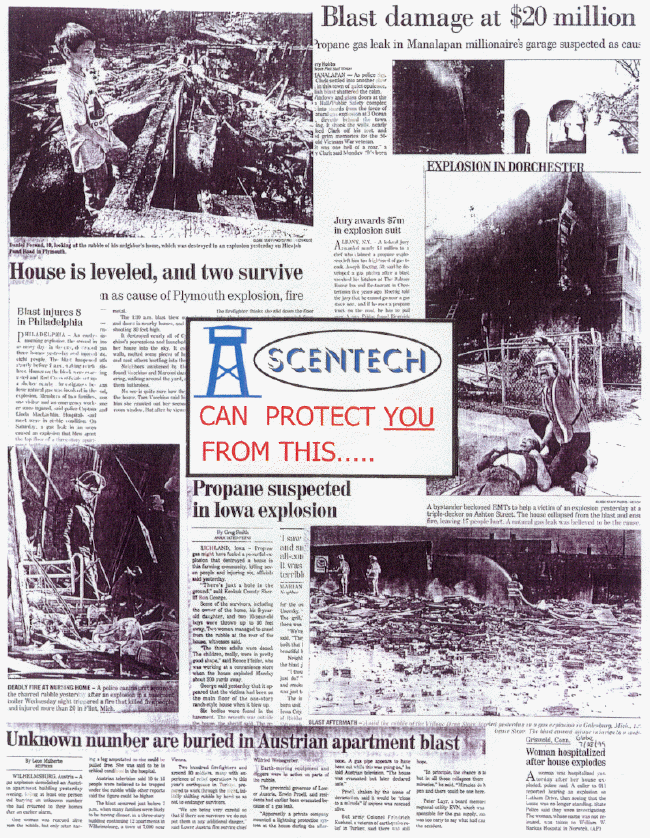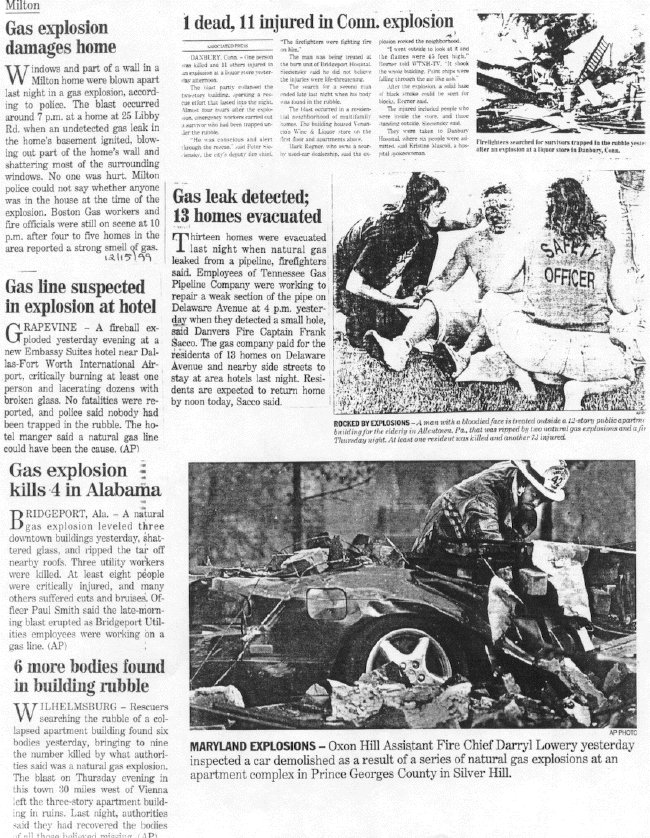
The "QuadrAlert Lifeguard" Gas Leak & Smoke Detector, by Scentech U.S. Patent # 5,563,578

The Problem ...
Though convenient, clean and efficient, gas energy is not without its well-known hazards! Without warning, at any time or any place, a gas leak can result in a catastrophe. The cause may be due to equipment failure, corrosion of piping inside the dwelling, or even gas seeping in around water pipes, conduits, etc., from an aging main out in the street!
THE POTENTIAL ALWAYS EXISTS. The news clips at the bottom of this page dramatically illustrate the users' vulnerability.
Including both distribution and transmission statistics compiled by the Department of Transportation (WWW.OPS.DOT.GOV) between 1986 and 1999, a major leak 'incident' occurred in this country on an average of once every 1.5 days, resulting in $476 million in property damage, and a combined figure of 1,345 injuries and deaths; one every 3.5 days. Boston Gas alone responds to 10,000 legitimate leaks of various sizes every year!
According to the Arbor Corporation's confidential consumer attitude survey conducted for the American Gas Association, the public's chief concern with natural gas is the perceived risk of explosion, leaks and/or fire. The consulting organization thus recommended that the gas companies should, in some way, help consumers manage these perceived safety risks.
The Problem ...
Though gas is odorized so that leaks can be detected by scent, it is not possible to smell it when it is below floors or when the heating equipment is located in a closed closet.
Attenuation of sound through floors and walls is so great, even in the smallest home, that, in most cases, a stand-alone detector/alarm meeting the minimum UL requirements could not rouse a sleeping home-owner during an emergency!
It is clear that the residential gas industry would benefit greatly if its customers and future customers were made to feel more secure and confident in the use of this form of energy.
The industry is lacking a definitive monitoring instrument that would perform this function.
The Solution ...
Introducing the QuadrAlert Lifeguard, by Scentech.
.... nothing in the industry comes close.....

LEFT: Wireless Remote Audio/Visual Annunciator/Display
RIGHT: Master Unit
... Fully integrated, FOUR separate detector/alarm functions provide an unprecedented comprehensive monitoring of the gas furnace area for:
featuring:
![]() ... Your Gas Heat
Partner
... Your Gas Heat
Partner
Though possessing a good safety record, gas energy is not without its well-known hazards. Gas leak detectors, now required by law in Europe and Asia, will see the same explosive growth rate in North America as was seen by the smoke detector in the 70's. Our instrument will guard against loss of life and property, and will instill security and confidence in the user of this form of energy.
SCENTECH has taken pride in creating the best product of its kind, at an affordable price, consistent with the highest standards.
THE PRODUCT -- The QUADRALERT LIFEGUARD is a four sensing function, integrated detector/alarm system with a wireless remote sounder, which offers comprehensive monitoring of the furnace area in homes which heat with gas energy.
THE ADVANTAGE -- Only The QUADRALERT LIFEGUARD offers detection of gas, carbon monoxide, temperature extremes and smoke in a single unit. Its wireless remote alarm ensures the rousing of sleeping home dwellers and annunciates the cause of trouble with distinct, separate audio codes: no need to enter the affected area! In addition, the instrument can connect to existing automatic dial-out security systems, and with its accessory louvered vent fan, can render either carbon monoxide or natural gas leaks harmless by expelling it to the outside ... unparalleled security
THE FEATURES:
1. CO (carbon monoxide): two
dashes – –
cause: damaged or clogged flu, chimney, etc.
2. GAS: three dashes
– – –
cause: equipment failure, corroded piping
3. TEMP (temperature extremes):
four dashes – – – –
cause: high (red lamp):
fire, stuck thermostat, etc.
low (blue lamp): equipment failure, alerts
before pipes freeze
4. SMOKE: continuous
dashes – – – – – – – – – – –
–
cause: fire
5. FAULT: continuous one second
dits - - - -
- -
cause: (amber
lamp): sensor failure, repair required
Technically Speaking ...
The following news clips illustrate the users' vulnerability:


Inventor: Bob Isenstein, 12 Exeter Drive, Woburn,
MA 01801
Phone: (781) 932-0304
E-mail: SCENTEK@aol.com
since April 3, 2003
(Good til July of 2013)